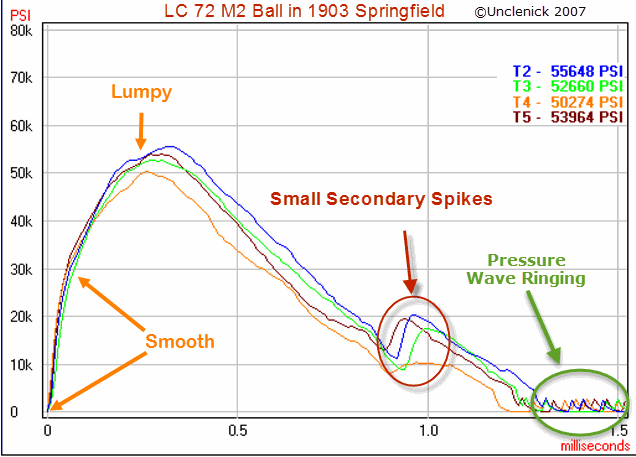That assumes they would be aware of it. You can ring a barrel without affecting accuracy appreciably until it gets severe, and if you don't look with a borescope, you may decide it isn't there. Because the measured spike is actually a ripple in the steel traveling back from where the localized pressure spike actually occurs, and is not a pressure change at the chamber, it is not detected by either a copper crusher or a piezo transducer that samples chamber pressure. Only the strain gauge shows it because it is measuring expansion of the whole chamber as a pressure indicator and not directly measuring gas pressure. Strain gauges are not included as a method in the SAAMI standard. The transducer housings all ride the surface of the metal so that if it showed on them at all, it would appear as a dip in pressure from lifting the transducer body away from the pressure source momentarily.
When Charlie Sisk reported his experiments (either 24 Hour Camp Fire or THR; I've forgotten which) he said he did the muzzle blow-off demo for several industry persons and that they basically shrugged their shoulders and did nothing with the information. They felt the SAAMI standard covered their backsides, apparently, and that's all they were interested in. SAMMI doesn't address the visible-by-strain-gauge-only phenomena.
Hunter Customs said:
If that's the case my reloading manual list H335 as being slower then BLC-2, as a matter of fact they list BLC-2 and Win 748 as being the same in burn rate.
BL-C(2) being close to 748 is correct, but H335 being slower is not. If you look at all the different burn rate charts you find a lot of powders are ranked differently in different burn rate charts. Nobody's paying to measure all these powders, so I think they try to guess based on what cartridges they are commonly used in and what velocities they achieve with particular bullets with what charge weight.
That H335 is WC844 and BL-C(2) is WC846 is published in Hodgdon's 2009 MSDS. They may not know the burn rates for powders from other distributors very exactly, but for the ones they distribute they keep the buirn rate specifications for ordering purposes, so their burn rate chart will be the most accurate for the powders they distribute. It ranks BL-C(2) in position 104, next to 748, and H335 in position 82, next to Benchmark. A lower number is faster on their chart. QuickLOAD's powder data is based on vivacity bomb measurements of actual samples (though the tested lots may not match the target burn rate spec exactly). It gives BL-C(2) a burn rate in units of 1/bar-s of 0.5150, while H335 is at 0.6300, or about 22% faster.
The military specs ammunition not only as to a peak pressure upper limit but also has a required gas port pressure window and a tighter velocity tolerance than SAAMI uses for the same bullet weights, This is in order to keep existing guns operating and existing sight systems calibrated correctly. You can guess from their finding that WC846 was too slow for 5.56 that it probably raised the gas port pressure too high when the velocity was correct.

